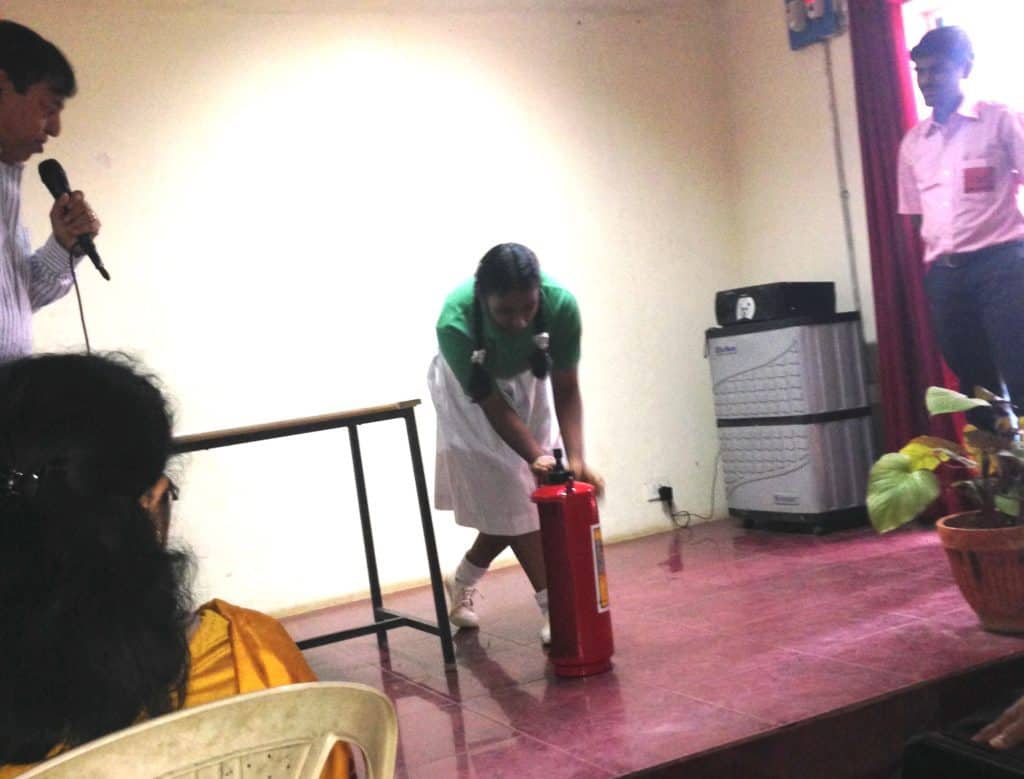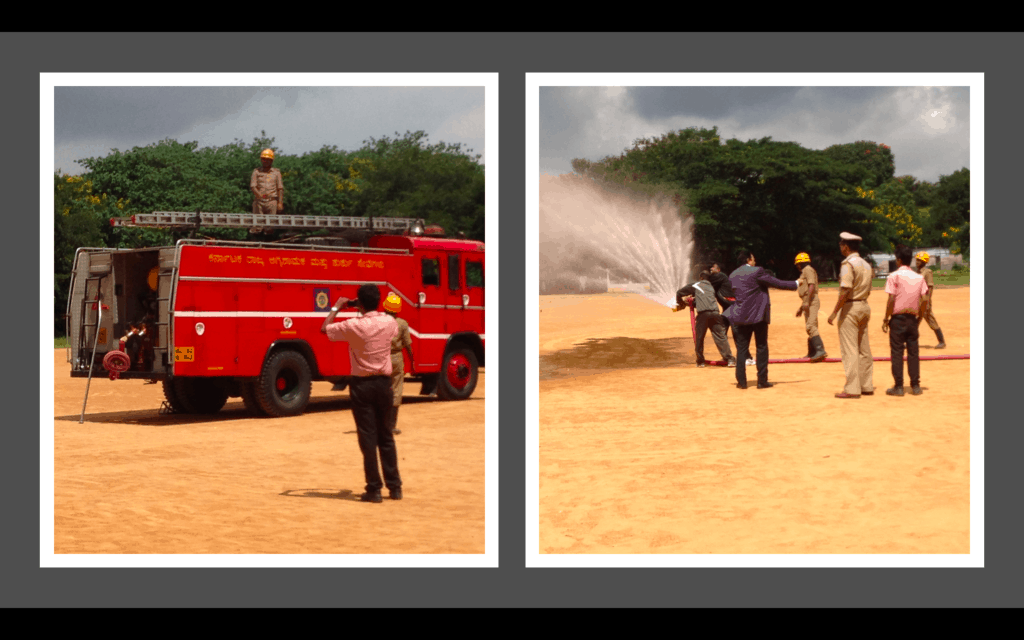‘Stay safe’ is now a stock phrase. Everyone uses it when signing off an email, chat or conversation. Yet another term that has gained currency is ‘bubble’. A bubble is a safe environment where social networks follow a shared set of norms to keep everyone there safe. The pandemic has led to heightened safety concerns, and in turn created awareness around behaviours that can likely protect us from COVID.
It is time we did the same with fire safety!
A culture of safety is one that is cultivated daily, and only strengthened during an emergency. At a recent webinar conducted by Citizen Matters, an alert parent speaking on fire safety in schools was a welcome change. It’s not often that this concern comes up in a discussion around school infrastructure
What made Chaitra M feel concerned about the fire safety preparedness in her child’s school? She said, “I was reading up on common issues in schools, and I chanced upon the Kumbakonam fire accident of 2004 in which 94 children lost their lives. It was a small school. It made me concerned about why such things happen, and why due attention is not given to safety in schools. I also noticed that a significantly large number of schools do not prioritise fire safety. I believe safety should be the first priority. We have to be prepared. We have to ensure that there is no loss of life.”

In the policy guidelines prepared by the NDMA, School Safety encompasses “the creation of safe environments for children, starting from their homes to school and back.” To deal with the risk of fire, we need to change our behaviours around fire safety in the home-to-school bubble.
Read More: In schools, hospitals or shrines, you can’t escape fire risk in urban India
Three elements of a safety framework
- First, ‘space’ familiarity, linked to spatial awareness of the school, home and neighbourhood premises
- Second, ‘participant’ familiarity and the roles everyone can play
- Third, ‘response’ familiarity, with a focus on training, awareness, and hands-on regular fire-safe practices
The space
Aware and alert behaviours start with familiarity of the school’s infrastructure and facilities. This enables quick response in case of a fire.
When Chaitra had enquired about the fire safety plan in her child’s school, she was met with ignorance: “I asked a teacher about the fire safety plan – ‘where are the safety exits, do you have a building plan handy?’ The teacher’s response was surprising – ‘why do you think there will be a fire in a school? It won’t happen here!’ I asked her – ‘what if kids are in the basement which is not well ventilated?’ She was unaware of any fire safety practices. I also asked if there was a fire alarm or sprinklers, and they did not have it. They hadn’t even applied for the fire safety NOC (No Objection Certificate)!”
However, establishments like Frank Anthony Public School (FAPS) in the city have taken exhaustive measures for fire safety. Kevin Pope, Principal of the school, speaks of the importance of identifying vulnerable areas in the school’s infrastructure: “Ours is a big establishment with almost 3000 students. Safety is a priority. I always felt, ‘you never know when a fire can happen’. So I took the first steps to initiate fire safety measures on a full scale. Every time I reviewed the school’s infrastructure, I felt the basement could be a death trap should any fire disaster happen.”
Structural changes may be needed, as was the case with FAPS. Kevin explains, “In every classroom, we installed a Fire Safety Door – a special, fire-resistant door. Every classroom has a wooden door at the main entrance, and at the back, the white-coloured Fire Safety Door. From inside there is a bar to the door; when it is pressed, the door opens.” The masonry work was done when children were on vacation. Kevin adds, “The cost was high, but a child’s safety is more important. We had the full support of the management. This decision has given us peace of mind.”
The Directorate General of National Disaster Response Force(NDRF) and Civil Defence, in a manual ‘School Fire Safety Management Plan’, outlines the importance of a fire safety plan for each school.
The school’s fire safety plan should have details of:
- Demography of the school; and its physical scenario, which includes a pictorial map of entry and exit signages, classrooms, staff rooms, laboratories, playgrounds and open spaces
- Resource mapping – of the staff trained to respond to a fire, as well as of fire-safety equipment like extinguishers, first-aid box, ropes, and so on
- Mapping critical resources like nearby fire stations, hospitals, Primary Health Centre, volunteer organisations, police stations, water supply booster pumps
- Vulnerability mapping and alternative solutions
- Evacuation map and designated safe spots
This document also informs and assures parents of the school’s commitment to their child’s safety.
Read More: A guide to fire safety in hospitals
Kevin attributes his success in ensuring a robust fire safety plan at FAPS to a collaboration with the Directorate of Fire and Emergency Services. “The paperwork took two years. We wanted every part of this exercise to be done thoroughly. It’s important to collaborate and we followed the advice of the Karnataka Fire & Emergency Services to the letter, as per the legal requirements. People from the department made a physical inspection of the school buildings and premises, and understood the ground reality. Everything was put in place as per their recommendation. It was then inspected again, and they had to be satisfied with the equipment, installation of gadgets, and the training.”
The participants
All participants in the home-to-school bubble need to be familiar with the shared safety norms, and the roles they can play. The school safety plan and measures taken should be shared with parents, students, teachers and non-teaching staff. This will empower them to be alert and to collaborate effectively during a crisis.
The school administration has to ensure compliance and a fire-safe environment for children. They should have an emergency plan document prepared in an inclusive manner, and should create awareness about the plan.
Following is an outline of the role of different stakeholders.

Chaitra believes the first education begins at home:
“We need to educate our children on fire safety at a basic level. Teach them how to respond in case of a fire at school, how to use a fire extinguisher and the staircase, and how to help each other. We need to ensure that the school has at least two fire-safety drills a year, and that all staff know what to do in case of a fire.”
The response
Active participation from each one in the bubble is key to timely response. This requires regular training, fire drills, and awareness-building exercises.
FAPS, for example, is geared for quick response. Kevin speaks of the reinforcement in the vulnerable basement area: “We have installed five fire sprinklers and fire alarms. There is now a pipe running in the main building from the basement to the top three floors, with hose reels (flexible water pipes) which can run 30-40 metre into any classroom. They are located on the left or right of every floor. Also, in case of an emergency there is a PA system just near my office. An announcement can be made, and children can be evacuated swiftly.”
Kevin says, “ To get the fire-safety certificate, there needed to be trained individuals from the school itself. So some teachers and support staff have been trained and given a certificate. We also create awareness among children and parents about the fire safety procedures. The fire and emergency service staff come in with their firemen and equipment, and conduct drills to make students and staff conscious of the importance of fire safety and timely response in case of fire.”

Clearly, a commitment to safety must rise above concerns of cost, bureaucratic processes, and the challenges of maintaining fire-safety equipment. By ensuring the preparedness of the space, participant and response systems, we can ‘stay safe’.
So, let’s put fire safety in our bubble!
References:
- National Disaster Management Guidelines, February 2016.
- Ahmedabad Action Agenda for School Safety, Outcome document of the International Conference on School Safety, 18th – 20th January, 2007, Ahmedabad.